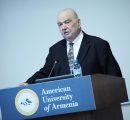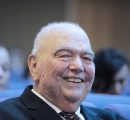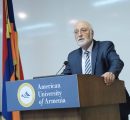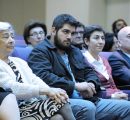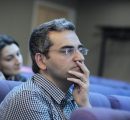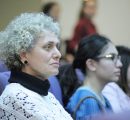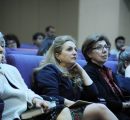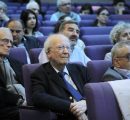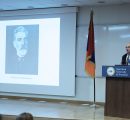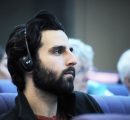
Dr. Richard Hovannisian Delivers Series of Lectures in Celebration of First Armenian Republic Centennial
4 min readYEREVAN, Armenia ‒ On April 16, 18, and 20, 2018, the American University of Armenia (AUA) and the Armenian General Benevolent Union (AGBU) Armenia co-hosted a lecture series by eminent historian Dr. Richard Hovannisian. The lectures were dedicated to the centennial of the First Armenian Republic. AUA President Dr. Armen Der Kiureghian introduced Dr. Hovannisian, who is an Armenian-American historian and professor emeritus at the University of California, Los Angeles.
“This year marks the centennial of the First Armenian Republic. […] As a university, the best way for us to commemorate this anniversary is to provide a scholarly examination of its history and significance. There is no scholar in this world who is more qualified to speak about this subject than Professor Richard Hovannisian. His four volumes on the history of the First Republic, which are now translated into Armenian and Russian, are the definitive works on the subject,” Dr. Der Kiureghian noted.
Dr. Der Kiureghian also expressed his gratitude to AGBU, represented by Vasken Yacoubian, AGBU Armenia President and AGBU Central Board member, for sponsoring the lecture series.
“As the world’s largest organization committed to the development and prosperity of all Armenians, AGBU has always been supporting the Armenian statehood, irrespective of the governing system. The 100th anniversary of the First Armenian Republic is not only a good occasion to celebrate, but it is also an occasion to appreciate, evaluate, and learn lessons from the history, to become more powerful and united in the face of current challenges,” said Yacoubian.
During the first lecture titled “May 28: The Uncharted Course Toward Independence,” Dr. Hovannisian presented the conditions during World War I which made the road to independence extremely treacherous. According to Dr. Hovannisian, in 1918, when the Russian armies withdrew from the Caucasus and the Turkish army reclaimed six provinces including Batum, Kars, and Ardahan, the Armenians were facing a difficult situation and sought the support of their neighbors. Thus, the Transcaucasian Federation was established, which was on the territory of present-day Armenia, Azerbaijan, and Georgia, as well as parts of modern-day Turkey and Russia. But the new country did not have a strong foundation and the Turkish invasions to conquer more territories, among which were Tiflis, Alexandrapol, and Echmiadzin, continued until May 26, 1918, when Georgia declared independence.
“That was followed, a day or two later, by the Muslim National Council declaring the independence of Azerbaijan, a name that we have not heard before in the Caucasus because Azerbaijan or Atrpatakan, for the Armenians at least, was the area of Tabriz, northern Iran,” noted Dr. Hovannisian. So, Armenians were left in a lurch because Georgia had declared the independence of their state and the Azerbaijanis, in their turn, wanted to appropriate eastern and southern Transcaucasia. It was under these circumstances that Armenia decided to declare independence to take control of its provinces.
The focus of the second lecture titled “Creating the Republic’s Infrastructure,” was the measures taken to lay the foundations of a republican form of government, while also dealing with internal tensions, not only among the several Armenian political parties, but especially within the dominant Dashnaktsutiun party, as well. Dr. Hovannisian noted that in 1919 the Armenian Populist Party boycotted the national parliamentary election and the latter was held without their participation. This was a serious blow to the development of the infrastructure of the First Republic of Armenia, as the only real liberal party that could draw around it the Armenian bourgeoisie and intellectuals did not take part in the elections.
At the same time, the elections had proportional representation of all citizens and residents of Armenia who were eligible to vote regardless of race, religion, and sex. “This is an enormously progressive concept when you remember that many countries still had not given women the right to vote,” Dr. Hovannisian remarked. In addition, he emphasized the crucial role of the Diaspora, who were yearning to return to their historic homeland when they learned about a united Armenian state. The establishment of the first Armenian university in Alexandrapol was another factor which contributed to the formation of the First Republic’s infrastructure. Dr. Hovannisian said that although Armenia had to struggle for its independence it was also the right time to focus on enlightenment and education of the population.
The concluding lecture titled “Armenia in the International Arena and an Assessment” touched upon such issues as expanding the territory of the small Armenian state, the realization of a “Free, Independent, United Armenia,” and the efforts of Armenian diplomats and Armenophilic world leaders to gain support for the Republic on five continents, among others. The response of the Great Powers was critical in that endeavor, and it was a question of whether they would commit the resources necessary to honor their wartime pledges regarding the future of the Armenian people. The collapse of the First Armenian Republic in December 1920 gave the answer to that question. As the Republic passed into history, strongly divergent views became manifest regarding its actual significance. Dr. Hovannisian considered the question about the implications of the First Armenian Republic.
The lecture series was in English, while simultaneous interpretation into Armenian was also provided. In addition, the sessions were livestreamed by the AGBU Armenian Virtual College (AVC) and those who were not able to attend the event series had the opportunity to ask questions online. The video recordings of the three lectures are available on YouTube: “May 28: The Uncharted Course Toward Independence,” “Creating the Republic’s Infrastructure,” and “Armenia in the International Arena and an Assessment”.
Founded in 1991, the American University of Armenia (AUA) is a private, independent university located in Yerevan, Armenia, and affiliated with the University of California. AUA provides a global education in Armenia and the region, offering high-quality graduate and undergraduate studies, encouraging civic engagement, and promoting public service and democratic values.
The Armenian General Benevolent Union (AGBU) is the world’s largest non-profit Armenian organization. Established in 1906 and headquartered in New York City, AGBU preserves and promotes the Armenian identity and heritage through educational, cultural and humanitarian programs, annually touching the lives of 500,000 Armenians around the world. More about AGBU programs worldwide: www.agbu.org. More about AGBU Armenia: www.agbu.am.
Media Coverage:
[Armenia TV] Ռիչարդ Հովհաննիսյան. Հայաստանի 1-ին հանրապետությունը պահպանելու համար սուպեր ուժ էր պետք
[Asbarez] Richard Hovannisian Speaks at Republic of Armenia Centennial Conferences

